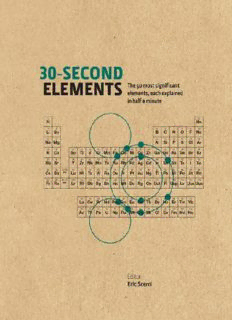Table Of Content30-SECOND
ELEMENTS
The 50 most significant elements, each explained in half a
minute
Editor
Eric Scerri
Contributors
Hugh Aldersey-Williams
Philip Ball
Brian Clegg
John Emsley
Mark Leach
Jeffrey Moran
Eric Scerri
Andrea Sella
Philip Stewart
First published in the UK in 2013 by Icon Books
Omnibus Business Centre 39–41 North Road
London N7 9DP
email: [email protected] www.iconbooks.net
© 2013 by Ivy Press Limited The editor and contributors
have asserted their moral rights.
No part of this book may be reproduced
in any form, or by any means, without
prior permission in writing from
the publisher.
This book was conceived, designed and produced by
Ivy Press
210 High Street, Lewes, East Sussex BN7 2NS, UK
www.ivypress.co.uk
Creative Director Peter Bridgewater
Publisher Jason Hook
Editorial Director Caroline Earle
Art Director Michael Whitehead
Project Editor Jamie Pumfrey
Designer Ginny Zeal
Illustrator Ivan Hissey
Glossaries Text Charles Phillips
Science Editor Sara Hulse
ISBN: 978-1-84831-616-4
Colour origination by
Ivy Press Reprographics 10 9 8 7 6 5 4 3 2 1
CONTENTS
Introduction
Alkali & Alkaline Earths
GLOSSARY & ELEMENTS
Sodium
Potassium
Francium
Profile: Dmitri Mendeleev
Magnesium
Calcium
Radium
30 Rare Earths
GLOSSARY & ELEMENTS
Promethium
Europium
Gadolinium
Protactinium
Uranium
Profile: Glenn T. Seaborg
Plutonium
Halogens & Noble Gases
GLOSSARY & ELEMENTS
Fluorine
Chlorine
Iodine
Astatine
Profile: Sir William Ramsay
Helium
Neon
Argon
Transition Metals
GLOSSARY & ELEMENTS
Chromium
Iron
Copper
Technetium
Profile: Emilio Segrè
Silver
Hafnium
Rhenium
Gold
Mercury
Copernicium
Metalloids
GLOSSARY & ELEMENTS
Boron
Silicon
Germanium
Arsenic
Antimony
Tellurium
Profile: Marie Curie
Polonium
Other Metals
GLOSSARY & ELEMENTS
Aluminium
Gallium
Profile: Paul Émile Lecoq de Boisbaudran
Indium
Tin
Thallium
Lead
Non-metals
GLOSSARY & ELEMENTS
Hydrogen
Carbon
Nitrogen
Oxygen
Phosphorus
Sulphur
Profile: Pekka Pyykkö
Flerovium
Ununseptium
APPENDICES
Notes on Contributors
Resources
Index
Acknowledgements
INTRODUCTION
Eric Scerri
Interest in the elements and the periodic table has never been
greater. Of course, we were all exposed to the periodic table at some
point in school chemistry. Everybody remembers the chart that hung on
the wall of the chemistry lab or classroom – parts of which we may even
have been forced to learn by heart. The chart classifies all the known
elements, those most fundamental components that make up the whole
earth – and, indeed, the whole universe as far as we know.
But perhaps we didn’t appreciate at the time that the periodic table is
without doubt one of the most important scientific discoveries ever made
and is fundamental to our knowledge of chemistry today. The core idea is
deceptively simple – arrange the elements in order of increasing weight
of their atoms and every so often we arrive at an element that shows
chemical and physical similarities with a previous one. This doesn’t just
happen occasionally in the periodic table but is true of every single
element except the very first few, which, of course, have no earlier
counterparts in terms of atomic weight.
Dmitri Mendeleev
Russian chemist Dmitri Mendeleev was the first to propose the periodic table of elements as we
know it now, as well as predicting the existence of some undiscovered elements. He is commonly
referred to as the father of the peroidic table.
As a result of this behaviour, the linear sequence of elements can be
arranged in a two-dimensional grid or ‘table’, much like a calendar that
shows the recurring days of the week for certain dates in a given month.
In this way, the tremendous variety among the elements is brought
together into a coherent and interrelated form. Of course, these days we
use atomic number (number of protons) to order the elements. But
although this has solved a technical problem called ‘pair reversals’, it
does not change the periodic table in any major fashion.
Mendeleev’s table, 1871
Antoine Lavoisier’s 1789 catalogue of elements formed the basis for the modern list, but it was not
until Mendeleev’s early arrangement in 1869 and final proposal in 1871 that the periodic table was
born.
At the time Russian chemist Dmitri Mendeleev and a number of others
discovered the periodic system, there was no underlying explanation, no
apparent reason why the elements should hang together in this way. But
the very fact that all the elements could be successfully accommodated
into such an elegant system seemed to suggest deeper things to come.
Mendeleev was able to use the periodic table to predict the existence of
elements that had never been found before. Within about 15 years, three
of his best-known predictions came to be. The discovery of gallium,
scandium, and germanium solidified the notion that the periodic system
had latched onto a deep truth about the relationship between the
chemical elements.
Around the turn of the 20th century many physicists – including J.J.
Thomson, Niels Bohr and Wolfgang Pauli – set about trying to
understand what lies behind the periodic system. British physicist
Thomson, the discoverer of the electron, was one of the first to suggest
that the electrons in an atom are arranged in a specific manner that we
now call an electronic configuration. Danish physicist Niels Bohr refined
these configurations and provided what remains the gist of the
explanation for why elements, in fact, repeat every so often, or to put it
another way, why it is that certain elements fall into particular groups or
vertical columns in the periodic table. Bohr’s answer was that the
elements in any vertical column share the same number of outer
electrons, building on the emerging notion that chemical reactions are
driven by outer electrons.
Next, Austrian physicist Wolfgang Pauli provided a further refinement
to the notion of electronic configurations by suggesting that electrons
have a hitherto unknown degree of freedom, which became known as
‘spin’. To put it in a nutshell, attempts to understand the periodic system
contributed enormously to the development of quantum theory and these
quantum ideas, in turn, provided a theoretical foundation for the periodic
system of the elements.

